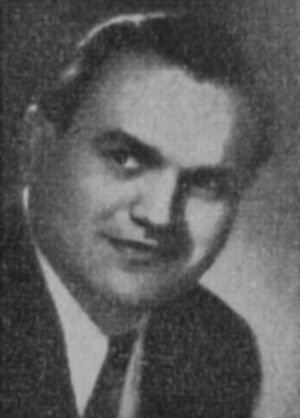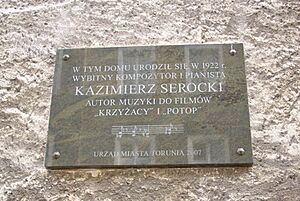Kazimierz Serocki facts for kids
Kazimierz Serocki (born March 3, 1922 – died January 9, 1981) was a talented composer from Poland. He was also one of the people who helped start the famous Warsaw Autumn festival, which is a big event for modern music.
Contents
Life and Music
Kazimierz Serocki was born in a city called Toruń. He loved music from a young age. He studied how to compose music and play the piano at a special music school in Łódź, finishing in 1946. He then went to Paris to continue his studies, learning from famous teachers like Nadia Boulanger. He finished his studies there in 1948.
For a few years, from 1946 to 1951, Serocki performed as a concert pianist in Poland and other countries. But after that, he decided to focus completely on composing music. He was especially interested in creating music for orchestras and pieces that combined voices with instruments, often using Polish poems.
One of Serocki's main ideas was to explore different "sound colors" in his music. This means he liked to use various instruments and sounds in new ways to create interesting textures and feelings. His very last piece, called Pianophonie (from 1979), even used electronic tools to change the sound of a live piano. This was quite advanced for his time!
Serocki was a very important person in the world of modern music. In 1956, he helped create the Warsaw Autumn festival with another composer named Tadeusz Baird. This festival became a major event where new and exciting music from around the world could be heard. He also formed a group of composers called Group 49 with Tadeusz Baird and Jan Krenz.
He received many awards for his music, both in Poland and from other countries. For example, in 1952, he won a State Prize for the music he wrote for a film called Young Chopin. He also won an award from UNESCO in 1959 for his piece called Sinfonietta. Kazimierz Serocki passed away in Warsaw when he was 58 years old.
Important Musical Works
Kazimierz Serocki wrote many different kinds of music. Here are some examples of his works:
Music for Small Groups of Instruments (Chamber Music)
- Suite for 4 trombones (1953)
- Continuum - a piece for six percussion instruments (1966)
- Swinging Music for clarinet, trombone, cello or double bass, and piano (1970)
Music for Orchestras and Concertos
- Romantic Concerto for piano and orchestra (1950)
- Concerto for trombone and orchestra (1953)
- Sinfonietta for two groups of string instruments (1956)
- Niobe - music for a poem, using two speakers, a choir, and an orchestra (1966)
- Forte e piano - music for two pianos and an orchestra (1967)
- Pianophonie - for piano, electronic sound changes, and orchestra (1976-1978)
Music for Solo Instruments
- Suite of Preludes for piano (1952)
- Brownies (Krasnoludki) - seven short pieces for children to play on the piano (1953)
- Sonata for piano (1955)
Songs for Voice and Piano
- Heart of the Night (Serce nocy) - a group of songs for a male singer and piano (1956)
- Eyes of the Air (Oczy powietrza) - a group of songs for a female singer and piano (1957)
Music for Choirs
- Songs of Midsummer Night - a suite based on folk texts for a mixed choir (1954)
See also
- Polish School (music)



